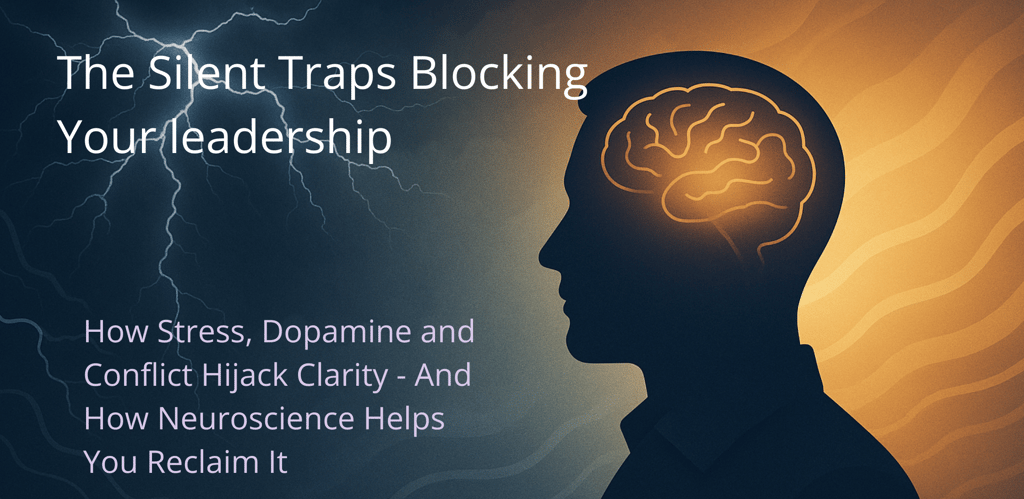The Silent Traps Blocking Your Leadership: How Stress, Dopamine, and Conflict Hijack Clarity—And How Neuroscience Helps You Reclaim It
Stress, conflict, and dopamine often conspire to pull leaders out of clarity and into reactivity. This post unpacks the neuroscience behind those “silent traps” and offers practical tools to help you pause, reset, and lead with calm focus under pressure.
8/21/20253 min read


We all know that moment:
The tight deadline.
The email that lands wrong.
The subtle shift in a colleague’s tone that raises your guard.
You want to lead with calm and clarity.
But instead, something in you reacts—fast, tight, and defensive.
That’s not a mindset problem. It’s a neurochemical one.
Stress Hijacks the Prefrontal Cortex
In a stressful moment, your brain activates its ancient survival system.
Heart rate spikes. Blood flow and resources shift toward survival systems. That means less energy for your prefrontal cortex—the part that handles strategy, empathy, and impulse control.
Your prefrontal cortex loses effectiveness under stress.
You don’t rise to the occasion.
You default to the pattern.
This is why even smart, emotionally intelligent leaders can find themselves snapping, avoiding, or micromanaging under pressure. The body thinks it’s in danger—and the brain responds accordingly.
What’s Dopamine Got to Do With It?
Dopamine is often misunderstood as the “pleasure chemical,” but it’s actually your motivation and reward signal.
It tells your brain:
“Do something—anything—to make this uncomfortable, stressed-out feeling go away.”
When you’re in conflict or under pressure, dopamine doesn’t make you calm or strategic.
It makes you chase relief.
You might:
Rush a decision just to get it over with
Reach for your phone, your inbox, or that third cup of coffee
Crave control—or an escape, such as a drink, a bet, or a cookie
But here’s the kicker:
Dopamine doesn’t care if the choice is helpful.
It just wants the discomfort to stop.
So in high-stakes leadership moments, your inner operating system might be pulling you toward urgency, distraction, or sedation—unless you consciously redirect it toward intentional, longer-term action.
Conflict Narrows Perspective
Layer on top of that a difficult interaction or disagreement, and things get even tighter.
In conflict, your brain defaults to filtering for threat, not connection.
You start to assume negative intent.
You listen to defend, not to understand.
This is how clarity gets hijacked:
Stress clouds your awareness
Dopamine drives reactivity
Conflict shrinks your capacity for nuance
You’re still functioning—but you’re not leading from your highest self.
How Leaders Can Reclaim Clarity
The good news?
This isn’t permanent—and it’s not personal.
It’s physiological. And it can be interrupted.
Here’s how:
1. Regulate First
Before the response, the email, the decision—pause.
Take 60 seconds to breathe, shake it off, or step away.
Your nervous system needs to come back online before your leadership can.
You can’t lead from your prefrontal cortex if it’s offline.
2. Interrupt the Craving for Control
Ask yourself:
“Am I solving the real issue—or just chasing relief?”
Dopamine will push you toward quick fixes.
But great leadership often requires discomfort tolerance.
This is where emotional maturity meets executive function.
3. Widen the Lens
In conflict, try asking:
What story am I telling myself right now?
What might they be experiencing?
What would my wiser self say in this moment?
What assumptions am I making, and what questions do I need to ask?
These questions expand your awareness—and restore the very clarity that stress and conflict try to steal.
Final Thought
Stress and conflict are inevitable.
Losing clarity doesn’t have to be.
When leaders understand how their brain and body respond under pressure, they stop shaming themselves—or others—for being reactive.
They start leading from regulation, not reaction.
From curiosity, not craving.
And here’s the key: the brain can rewire. Repeatedly practicing regulation, pausing, and perspective-taking strengthens the prefrontal cortex. Over time, leaders become not just reactive managers of stress, but resilient architects of clarity.
We don’t need more hustle.
We need more groundedness.
More signal, less noise.
Because the leaders who can stay clear under pressure?
They don’t just manage teams.
They elevate them.
SYNERGYLM, LLC
liz.michael@synergylm.net
7901 4th St. N #25825
St. Petersburg, FL 33702
© 2025. All rights reserved.


